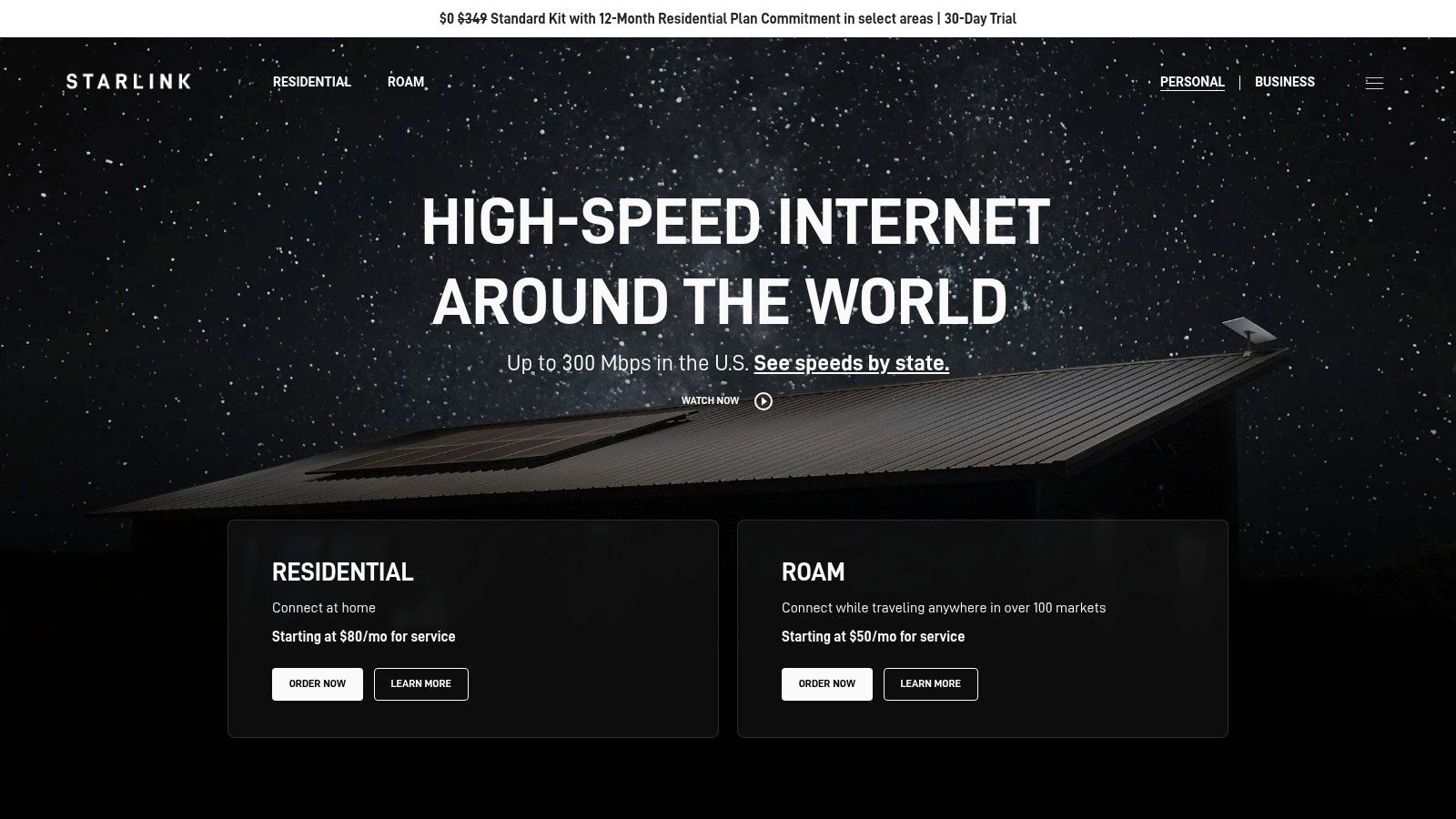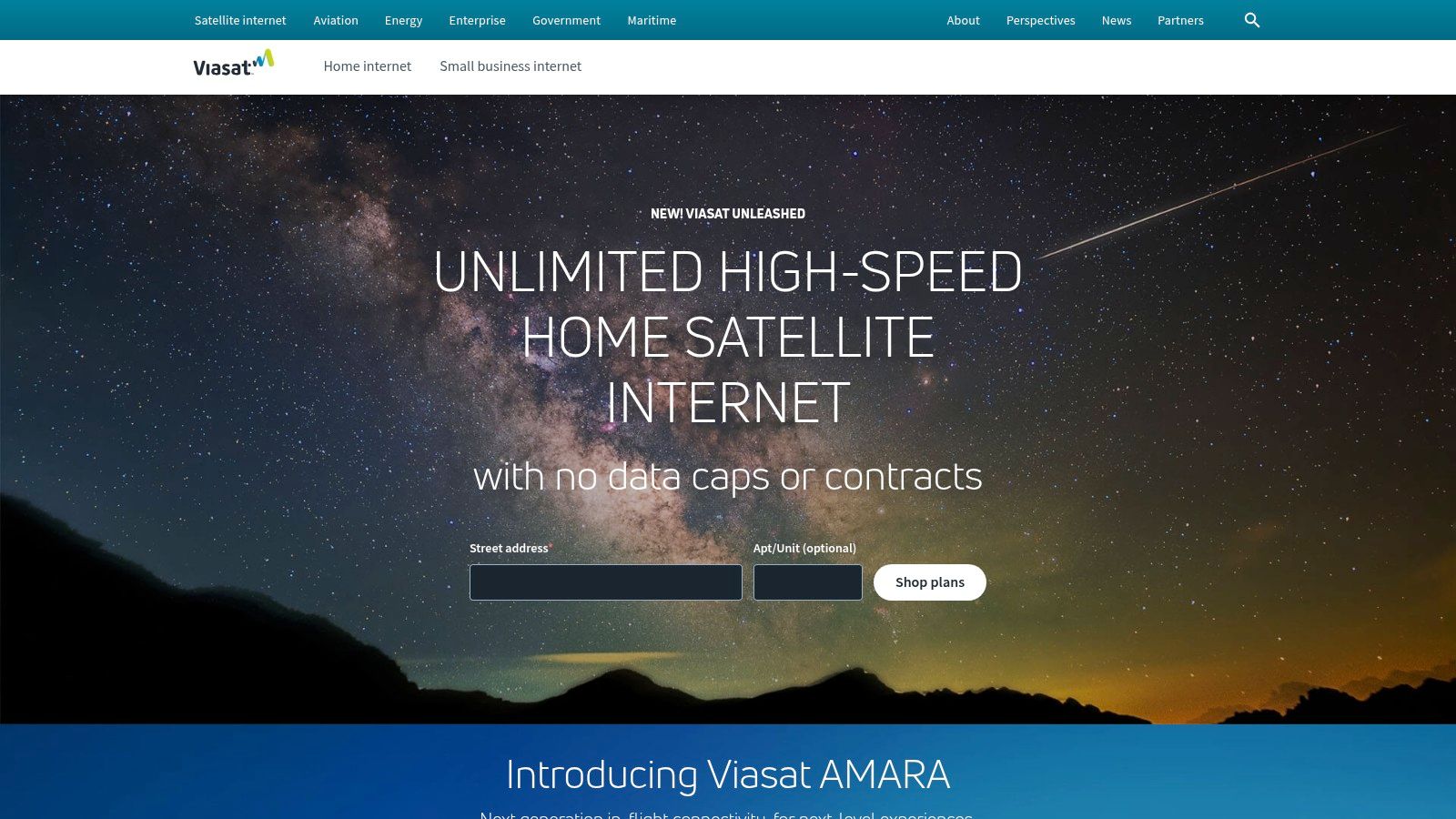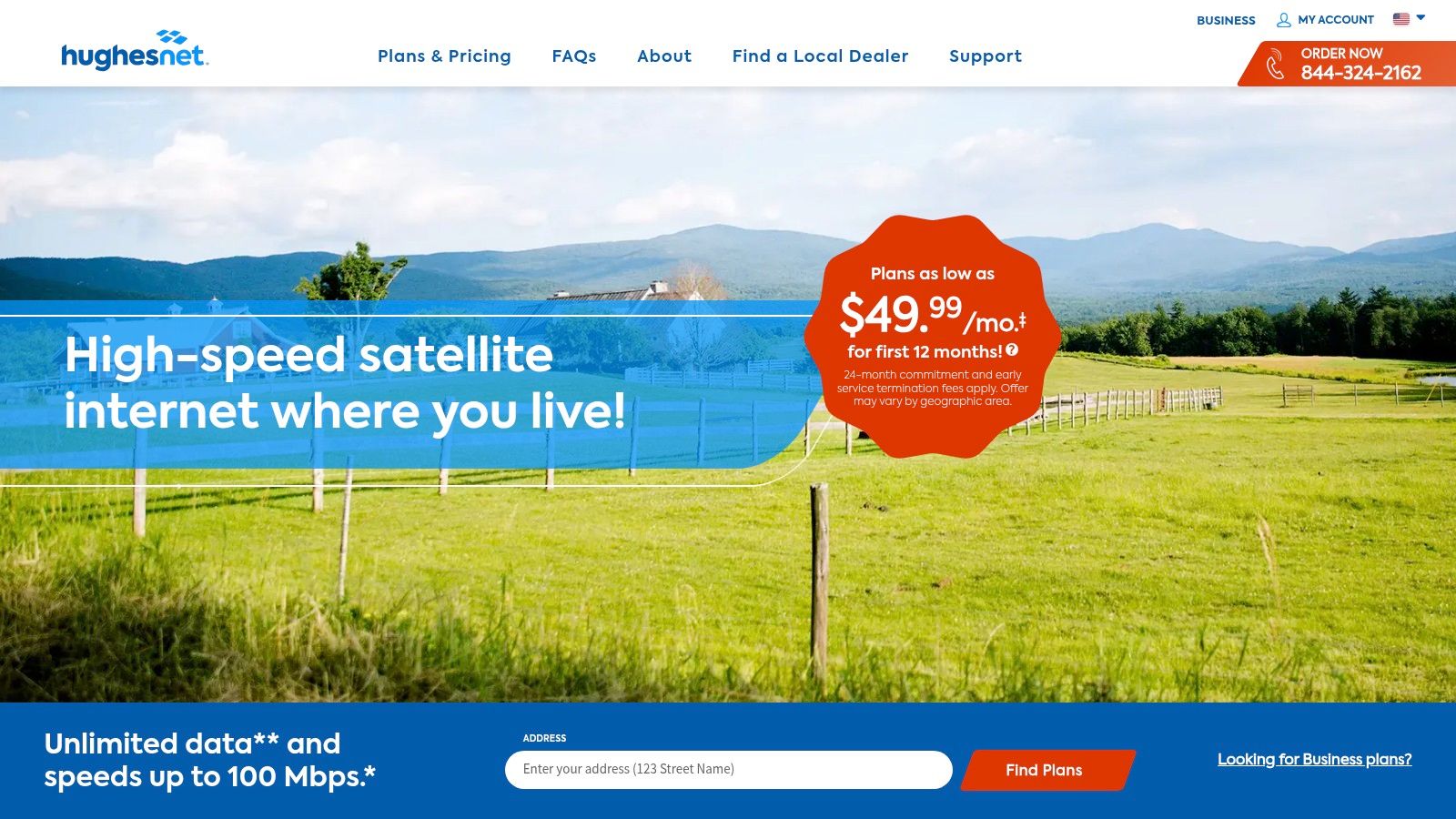

· Por James
Top Rural Internet Providers of 2025 | Fast & Reliable Service
Staying Connected in the Country: 2025's Best Rural Internet Options
Struggling to find reliable internet outside the city? This list of the top 8 rural internet providers for 2025 offers solutions for staying connected, whether you're an RV traveler, remote worker, or simply living in a rural area with limited options. We'll cover leading satellite internet providers, fixed wireless options, and emerging 5G home internet services, helping you choose the best connection for your needs. From Starlink to T-Mobile Home Internet and more traditional rural internet providers, discover the best way to stay online.
1. SwiftNet Wifi
SwiftNet Wifi offers high-speed 5G internet service designed specifically for rural areas and RV travelers. This makes it an excellent option for those seeking reliable connectivity beyond the reach of traditional wired providers. Whether you're working remotely from your rural home, streaming movies in your RV, or simply need a consistent connection for everyday tasks, SwiftNet Wifi aims to bridge the digital divide. Its focus on mobility and serving underserved areas makes it a valuable option for those struggling to find reliable rural internet providers.

For RV owners, SwiftNet Wifi provides the flexibility to stay connected on the road, enabling access to work, entertainment, and essential communication tools no matter where your travels take you. For residents of rural areas, it offers a viable alternative to slower DSL or satellite internet options, often being the only high-speed choice available. Learn more about SwiftNet Wifi for details on their blog posts discussing various topics related to rural internet connectivity.
Unfortunately, specific details regarding pricing, data limits, and technical requirements are not readily available on the SwiftNet Wifi website. It's advisable to contact them directly to obtain current pricing plans and understand the equipment needed for installation and setup. Information about the necessary setup process for RVs versus stationary rural homes would also be beneficial for prospective customers.
While SwiftNet Wifi’s focus on 5G technology promises faster speeds compared to older technologies like satellite internet, the actual speeds experienced will depend on location and network availability. It's crucial to confirm coverage in your specific area before committing to the service. Compared to other rural internet providers utilizing technologies like fixed wireless or LTE, SwiftNet Wifi's 5G offering potentially provides higher bandwidth and lower latency, though this needs to be verified based on real-world performance.
For those considering SwiftNet Wifi, researching the specific coverage in your rural location or along your planned travel routes is essential. Inquiring about installation requirements, whether self-installation is possible, and any potential data caps is highly recommended. This research will allow you to make an informed decision about whether SwiftNet Wifi is the right solution for your specific rural internet needs. Comparing their offerings to other available options in your area, such as satellite internet or fixed wireless, will help you identify the best provider in terms of speed, reliability, and cost.
2. Starlink
For those seeking reliable internet access in rural locations, Starlink is a game-changer amongst rural internet providers. This satellite internet service, developed by SpaceX, leverages a network of low Earth orbit (LEO) satellites to deliver high-speed internet with significantly lower latency than traditional satellite internet options. This makes it a viable option for those living off-the-grid, RV travelers, remote workers, and anyone in rural areas struggling with limited connectivity. Forget grappling with slow DSL or expensive, limited data plans; Starlink offers a modern solution for staying connected.

Starlink's self-installing equipment, including a dish and router, automatically positions itself for optimal signal reception. With download speeds typically ranging from 50-200 Mbps and latency between 20-40ms, it's a significant upgrade over many existing rural internet providers. This lower latency is particularly important for activities like online gaming and video conferencing, which often suffer with traditional satellite internet. Furthermore, residential Starlink service is typically free of data caps in most regions, allowing users to stream, download, and work without constantly monitoring their usage.
Technical Requirements and Pricing:
Starlink requires a clear view of the sky for the dish to connect with the satellites. The initial equipment cost is $599+, and the monthly subscription fee ranges from $110-$120. While this is more expensive than some wired internet options, the availability and performance in remote areas often justify the cost.
Pros:
- Availability: Starlink is available almost anywhere globally with a clear view of the sky, making it ideal for even the most remote locations.
- Speed and Latency: Significantly faster than traditional satellite internet and many other rural internet options, with low latency suitable for gaming and video conferencing.
- Ease of Installation: The self-installing equipment simplifies setup and requires no specialized technical expertise.
- No Data Caps: No data caps (in most regions) on residential plans allow for unrestricted internet usage.
- Independence from Physical Infrastructure: No need for phone lines or cable infrastructure in your area.
Cons:
- High Upfront Cost: The initial cost of the equipment can be a barrier to entry for some users.
- Monthly Cost: The monthly subscription is more expensive than many wired internet services.
- Weather Dependence: Service can be affected by severe weather conditions like heavy rain or snow.
- Obstruction Sensitivity: Trees, buildings, or other obstructions can interfere with the signal.
- Customer Support: Customer support options are currently limited compared to larger internet providers.
Implementation/Setup Tips:
- Check for Obstructions: Before purchasing, use the Starlink app to identify any potential obstructions that could impact your service.
- Optimal Placement: Place the dish in a location with a completely unobstructed view of the sky.
- Professional Installation (Optional): While self-installation is standard, professional installation services are available for those who prefer assistance.
Why Starlink Deserves Its Place on the List:
Starlink is a revolutionary solution for rural internet access, offering high-speed, low-latency internet in areas previously underserved by traditional providers. For RV owners, remote workers, and rural residents, Starlink provides a practical and powerful way to stay connected, regardless of location. While the cost is higher than some alternatives, the performance and availability make it a worthwhile investment for those seeking reliable internet in remote areas. Find out more at https://www.starlink.com/.
3. Viasat
For those seeking internet access in the most remote corners of the United States, Viasat is a prominent player among rural internet providers. Leveraging the power of geostationary satellites, Viasat blankets the country, offering a lifeline for those beyond the reach of terrestrial internet options like cable and fiber. This makes it a particularly attractive option for RV travelers, rural homeowners, and remote workers who need consistent connectivity regardless of their location. Viasat offers various plans with different download speeds and data allowances, aiming to cater to a range of needs and budgets. This flexibility is crucial for rural internet users, as their usage patterns can vary significantly.

Viasat’s extensive coverage makes it a valuable tool for individuals and families living in rural areas, especially where other options are limited or nonexistent. While download speeds can reach up to 100 Mbps in select areas, it's important to remember that actual speeds may vary based on location and network congestion. The included built-in WiFi router simplifies setup, a major advantage for those less technically inclined. Unlike some providers with strict data caps, Viasat employs data thresholds. This means that after you exceed your monthly data allowance, your speeds may be prioritized lower than other users, but you won't be completely cut off. This is a vital distinction for those relying on the service for work or essential communication. Viasat also offers 24/7 technical support, a critical feature for users in remote locations who may need assistance outside of regular business hours.
Features:
- Nationwide coverage through geostationary satellite technology
- Plans with download speeds up to 100 Mbps in select areas
- Built-in WiFi router
- Data thresholds rather than hard data caps
- 24/7 technical support
Pros:
- Widely available across rural America, making it ideal for RV travelers and remote workers.
- Multiple plan options cater to different needs and budgets.
- Reliable service in most weather conditions.
- Professional installation is included, streamlining the setup process.
Cons:
- High latency (600-700ms) can impact real-time applications like online gaming and video conferencing. This is a key consideration for gamers and those working remotely in roles requiring low-latency connections.
- Data thresholds can lead to slower speeds during peak usage times after exceeding the allowance.
- 2-year contracts with early termination fees require careful consideration of long-term needs.
- Higher monthly costs for higher-speed plans may be a barrier for some budget-conscious users.
Website: https://www.viasat.com/
Viasat earns its spot on this list because it fills a crucial gap in the rural internet landscape. While it may not offer the lightning-fast speeds of fiber optic connections, its widespread availability and reliability make it a viable solution for many rural users. When considering Viasat, it’s essential to weigh the pros and cons carefully, considering factors like latency, data thresholds, and budget. For those in remote areas with limited alternatives, Viasat offers a connection to the digital world, enabling everything from remote work and education to entertainment and communication.
4. HughesNet
HughesNet is a long-standing player in the rural internet provider landscape, leveraging satellite technology to reach areas where terrestrial internet options are limited or non-existent. This makes it a viable option for those living in rural areas, RV travelers, remote workers, and anyone else struggling to find reliable internet access outside of major cities. While all HughesNet plans offer a consistent 25 Mbps download speed, they vary in data allowance, making it essential to choose a plan that fits your specific usage needs. Their Bonus Zone feature, which provides 50 GB of extra data during off-peak hours (2 am - 8 am), is a valuable perk for those who can schedule larger downloads or updates overnight.

For RV travelers and remote workers, HughesNet’s nationwide availability is a major draw, offering consistent performance no matter where your travels take you. The built-in Wi-Fi and professional installation ensure a hassle-free setup process, while data-saving features like the video data saver help manage data consumption. This makes it a practical solution for staying connected while on the road or working remotely from a rural location. Those living in rural areas without fiber optics internet will find HughesNet a reliable alternative, offering a stable connection for everyday online activities like browsing, email, and social media.
While pricing information isn't readily available without contacting HughesNet directly, they do offer a transparent pricing structure based on data allowances. Technical requirements are minimal, requiring a clear view of the southern sky for optimal satellite reception. Compared to other rural internet providers like Starlink (which offers faster speeds but has limited availability) or fixed wireless options (which offer better latency but limited range), HughesNet shines in its consistent nationwide coverage. This is particularly beneficial for those constantly on the move or located in areas with limited infrastructure.
Pros:
- Consistent nationwide availability and performance
- Transparent pricing structure
- Bonus Zone provides flexibility for large downloads
- Reliable customer service with decades of experience
- Suitable for RV living, remote work, and rural homes
Cons:
- High latency (600+ ms) impacts real-time applications like video conferencing and online gaming.
- All plans limited to 25 Mbps download speed regardless of price tier.
- Speed throttling can be significant after exceeding data allowance.
- Two-year contract requirement.
Implementation Tips:
- Contact HughesNet directly to discuss available plans and pricing based on your data needs.
- Ensure a clear view of the southern sky at your installation location.
- Schedule professional installation for optimal setup and performance.
- Utilize the Bonus Zone and data-saving features to maximize your data allowance.
For more information and to explore available plans, visit the HughesNet website. HughesNet deserves its place on this list because of its comprehensive nationwide coverage and reliable performance, making it a dependable choice for rural internet access, despite the limitations of satellite internet technology.
5. T-Mobile Home Internet
For RV travelers, RV owners, remote workers, and those living in rural areas without fiber optic internet access, finding reliable internet can be a major challenge. T-Mobile Home Internet emerges as a viable solution for many, earning its place on this list of rural internet providers by offering a convenient and affordable fixed wireless option. Leveraging T-Mobile's extensive 4G LTE and expanding 5G cellular networks, this service brings internet connectivity to eligible rural locations previously underserved by traditional providers.
T-Mobile Home Internet distinguishes itself with its straightforward, contract-free approach. The service boasts unlimited data, eliminating worries about data caps or throttling, a common concern for those working or streaming online extensively. With average speeds ranging from 35-115 Mbps depending on location and network congestion, users can expect decent performance for everyday tasks like browsing, emailing, and video conferencing. While these speeds may not rival fiber optic connections, they often surpass the limited options available in many rural areas. Learn more about T-Mobile Home Internet
A key advantage of T-Mobile Home Internet is its simple, flat-rate pricing of $50/month with autopay for most customers, which includes all necessary equipment. This eliminates the burden of rental fees or upfront hardware costs, making it a budget-friendly option. Setup is also designed for ease of use. The included gateway device allows for self-installation, removing the need for a professional technician and appointment scheduling. This plug-and-play feature is particularly beneficial for RV travelers who frequently change locations.
Features:
- Utilizes T-Mobile's 4G LTE and 5G cellular network
- Unlimited data with no caps or throttling
- Average speeds of 35-115 Mbps (location-dependent)
- Simple flat-rate pricing with no additional equipment fees
- Self-installation with included gateway device
Pros:
- Affordable fixed price ($50/month with autopay for most customers)
- No contracts or hidden fees
- Unlimited data with no throttling
- Simple setup with no professional installation required
Cons:
- Limited availability based on tower capacity and location. Check availability on their website before making a decision.
- Speeds and reliability can vary significantly by location. Consider using a cell phone signal booster if you live in a fringe area.
- Performance may degrade during network congestion, particularly in densely populated areas or during peak usage times.
- No option to use your own router, limiting advanced network customization.
While T-Mobile Home Internet provides a valuable solution for rural internet connectivity, it's essential to be aware of its limitations. Availability heavily relies on tower capacity and your specific location. If you're in a remote area with limited cell service, this option might not be suitable. Additionally, while the unlimited data is a significant plus, speeds can fluctuate based on network congestion.
For those seeking an affordable, no-contract internet option in a rural setting, T-Mobile Home Internet offers a compelling solution. Its ease of setup, unlimited data, and competitive pricing make it a worthy contender among rural internet providers, especially for those embracing a mobile lifestyle or residing in areas with limited infrastructure. You can check availability and sign up at https://www.t-mobile.com/home-internet.
6. Rise Broadband: A Fixed Wireless Solution for Rural Internet Access
For those seeking reliable rural internet providers, Rise Broadband offers a compelling fixed wireless option, especially for those living beyond the reach of cable and fiber optic infrastructure. This makes them a viable choice for RV owners, remote workers, and rural residents seeking an alternative to slower DSL or costly satellite internet. Their focus on serving rural communities is a major plus for those who find themselves outside the service areas of larger providers.
Rise Broadband leverages tower-based technology to beam internet signals directly to a receiver installed at your home. This method bypasses the need for traditional cable or fiber lines, making it particularly attractive in areas where laying such infrastructure is challenging or cost-prohibitive. This makes it an attractive option for RV travelers who need internet access while parked in rural locations, as well as for those living in remote areas.
Features and Benefits:
- Fixed Wireless Technology: Utilizing line-of-sight communication with local towers, Rise Broadband offers a more stable connection compared to satellite internet, which relies on signals traveling vast distances to orbiting satellites.
- Speed Options: Plans typically offer download speeds between 25-50 Mbps in most service areas. This speed is sufficient for streaming video, online gaming, and video conferencing, making it suitable for both work and leisure.
- Data Plans: Rise Broadband caters to varying usage needs with both unlimited data and data-capped plans. Choosing the right plan depends on your anticipated usage patterns. For example, remote workers who frequently upload and download large files might benefit from an unlimited plan.
- Residential and Business Services: Rise Broadband provides services tailored for both homes and businesses, accommodating different bandwidth and usage requirements.
- VoIP Phone Service: An optional VoIP (Voice over Internet Protocol) phone service add-on allows you to bundle your phone and internet services, potentially saving on costs.
Pros:
- Lower Latency than Satellite: Experience less lag with latency typically between 10-50ms, compared to satellite internet which can experience much higher latency, making real-time applications like gaming and video calls difficult.
- Cost-Effective: Rise Broadband is often more affordable than comparable satellite internet plans, making it a budget-friendly choice for rural internet access.
- Local Support: Benefit from local customer service and technicians, potentially leading to faster response times and more personalized support.
- No Cable or Fiber Required: The wireless nature of the service eliminates the need for existing cable or fiber infrastructure, opening up connectivity options for more remote locations.
Cons:
- Limited Availability: Service is regional and not available nationwide. Check their website to determine availability in your specific area. This is a crucial consideration for RV travelers, who need to verify coverage at their intended destinations.
- Line-of-Sight Requirement: Uninterrupted line-of-sight between your home and a transmission tower is crucial for optimal service. Obstructions like trees or buildings can significantly impact performance. This can be a challenge for some RV setups depending on parking location and surrounding terrain.
- Weather Sensitivity: Severe weather conditions can occasionally disrupt the wireless signal, affecting internet service quality.
- Installation Fees: Be aware of potential installation fees, which can sometimes be substantial. Inquire about specific installation costs beforehand.
Pricing and Technical Requirements:
While specific pricing information is available on their website, it generally varies depending on location and chosen plan. Contact Rise Broadband directly or visit their website for the most up-to-date pricing details for your area. The primary technical requirement is a clear line of sight to a Rise Broadband transmission tower. A technician will assess your location during the installation process to ensure a viable connection.
Why Rise Broadband Deserves Its Place on the List:
Rise Broadband fills a vital gap in the rural internet landscape, offering a reliable and relatively affordable alternative to satellite internet and limited DSL options. Their focus on rural communities, combined with the benefits of fixed wireless technology, makes them a strong contender for anyone seeking robust internet access outside of urban areas.
Website: https://www.risebroadband.com/
7. AT&T Fixed Wireless
For those seeking rural internet providers, AT&T Fixed Wireless offers a viable solution, particularly within AT&T's existing cellular network footprint. This service leverages cellular tower technology to deliver broadband internet to eligible rural addresses, making it a practical option for those beyond the reach of DSL or fiber optic cables. This makes it particularly appealing to RV travelers, RV owners, and those living in rural areas without fiber optic internet access who need a reliable connection for work or leisure.
AT&T Fixed Wireless works by installing a fixed antenna on your home. This antenna connects wirelessly to nearby AT&T cell towers, providing a more consistent and stable connection than mobile hotspots. This stability is a boon for remote workers and online learners in rural locations who require a dependable connection.
Features and Benefits:
- Wireless Connection: Leverages AT&T's existing cellular network infrastructure, eliminating the need for digging and cable installation.
- Respectable Speeds: Provides download speeds of at least 10 Mbps, though actual speeds can vary and are often higher depending on location and network congestion. This allows for activities like streaming video and online gaming, although heavy users may experience limitations.
- Data Allowance: Comes with a 350GB monthly data allowance. While this is sufficient for many users, those who regularly stream high-definition video or download large files may find this restrictive. Overage charges are $10 per 50GB.
- Professional Installation: Includes professional installation of the external antenna, ensuring optimal placement and performance. This minimizes the technical expertise required from the user, although it does come with associated installation fees (which are not publicly listed and may vary).
- Bundling Options: Compatible with AT&T's WiFi gateway devices and can be bundled with AT&T wireless phone plans, potentially offering cost savings for existing AT&T customers.
- Reliable Customer Support: Backed by AT&T's established customer support network.
Pros:
- Stability: Offers a more stable connection than mobile hotspot solutions.
- Availability: Available in many rural areas within AT&T's coverage footprint.
- Bundling: Can be bundled with existing AT&T wireless services for potential discounts.
- Support: Benefits from AT&T's comprehensive customer support.
Cons:
- Speed Limitations: Speeds, while decent, are generally lower than other rural internet options like satellite internet (Starlink, HughesNet) or fixed wireless from smaller, local providers who may utilize newer technologies.
- Data Cap: The 350GB data cap can be a constraint for heavy internet users.
- Installation Fees: Requires professional installation, which comes with associated fees. Contact AT&T directly for a quote.
- Tower Dependence: Service quality can fluctuate depending on distance from the tower and network congestion.
Implementation Tips:
- Check Availability: Before committing, confirm service availability at your specific address on the AT&T website. Rural addresses within AT&T's cellular coverage area are the most likely to qualify.
- Understand Data Usage: Assess your typical monthly data consumption to determine if the 350GB allowance is sufficient. Consider how activities like streaming, gaming, and video conferencing impact data usage.
- Inquire About Installation Costs: Contact AT&T directly to get a clear understanding of the installation fees and any other associated costs.
- Compare with Alternatives: Compare AT&T Fixed Wireless with other rural internet providers available in your area, considering factors like speed, data limits, price, and customer service. This could include satellite internet providers and other local fixed wireless options.
Website: https://www.att.com/internet/fixed-wireless/
AT&T Fixed Wireless deserves a place on this list of rural internet providers because it offers a reliable and relatively straightforward solution for those in areas with limited broadband options. While not the fastest option, its stability and reliance on established infrastructure make it a strong contender for those prioritizing consistent connectivity. It's particularly well-suited for individuals and families in rural areas within the AT&T coverage zone looking for a more robust alternative to mobile hotspots.
8. Kinetic by Windstream
Kinetic by Windstream is a noteworthy option for rural internet providers, aiming to bridge the digital divide in underserved communities across 18 states, primarily in the Midwest and Southeast. This makes them a viable option for those seeking connectivity in areas often overlooked by larger providers. They offer a hybrid approach, leveraging existing DSL infrastructure while actively expanding their fiber optic network. This two-pronged strategy allows them to serve a wider range of customers, from those in areas with limited infrastructure to those ready for high-speed fiber connections. This commitment to expansion makes them a particularly interesting option for those living in rural areas hoping for future fiber availability.

Kinetic offers a range of internet speeds to suit various needs and budgets. DSL plans start at 25 Mbps, catering to basic internet usage like email and web browsing. For those seeking faster speeds for streaming, gaming, or working from home, Kinetic's fiber network offers speeds up to 1 Gbps where available. This scalability makes them a good fit for both casual users and those with more demanding bandwidth requirements. A significant advantage for users with high data demands, particularly those working remotely or streaming frequently, is the absence of data caps on all plans, regardless of whether you're on DSL or fiber. This "unlimited data" policy provides peace of mind and eliminates the worry of overage charges.
For RV travelers and those living in rural areas without fiber optic internet, the DSL option, while slower, can still provide a crucial connection for staying in touch and getting work done. For RV owners specifically, the lack of contracts for standalone internet service provides flexibility as they move between locations. People living in rural areas can also benefit from the local presence of Windstream technicians, allowing for potentially quicker service responses compared to national providers with less localized support. You can Learn more about Kinetic by Windstream.
While Kinetic by Windstream shows promise, it's important to be aware of the potential drawbacks. Their geographical availability is limited to 18 states, making them unsuitable for those outside their service area. DSL speeds can be inconsistent, varying based on distance from the equipment. Customers located further away may experience significantly slower speeds than advertised. Furthermore, customer service ratings have been reported as being below industry average, which is a crucial factor to consider for reliable support. Finally, while promotional pricing can be attractive, it often increases after the first year, so be sure to factor in the regular price when budgeting. Despite these downsides, Kinetic by Windstream's focus on expanding fiber in underserved rural areas and their unlimited data policy makes them a valuable contender for those seeking reliable rural internet providers.
Rural Internet Providers Comparison
| Provider | Core Features & Speeds | User Experience & Quality ★ | Value & Pricing 💰 | Target Audience 👥 | Unique Selling Points ✨ |
|---|---|---|---|---|---|
| 🏆 SwiftNet Wifi | High-speed 5G for rural & RV travelers | ★★★★☆ Reliable & fast | 💰 Competitive for rural 5G | 👥 Rural homes & RV users | ✨ Optimized for mobility & rural use |
| Starlink | LEO satellites, 50-200 Mbps, 20-40 ms latency | ★★★★☆ Lower latency, wide coverage | 💰 High upfront ($599+), $110/mo | 👥 Remote & rural users wanting fast & low latency | ✨ Automatic dish positioning |
| Viasat | GEO satellites, up to 100 Mbps | ★★★ Available & stable, high latency | 💰 Mid-high, with data thresholds | 👥 Rural USA needing reliable service | ✨ 24/7 support, professional install |
| HughesNet | GEO satellites, 25 Mbps constant speed | ★★★ Consistent but high latency | 💰 Moderate pricing, data throttling | 👥 Nationwide rural users | ✨ Bonus Zone off-peak extra data |
| T-Mobile Home Internet | 4G/5G cellular, 35-115 Mbps, unlimited data | ★★★★ Affordable, no contracts | 💰 $50/mo flat with autopay | 👥 Rural users near towers, contract-free | ✨ Unlimited data, no equipment fees |
| Rise Broadband | Fixed wireless, 25-50 Mbps, line-of-sight req. | ★★★★ Lower latency than satellite | 💰 Affordable, some install fees | 👥 Rural with tower line-of-sight | ✨ Local support & VoIP options |
| AT&T Fixed Wireless | Cellular-based, 10+ Mbps, 350GB data cap | ★★★ Stable, but lower speed | 💰 Moderate, with install fees | 👥 Rural within AT&T footprint | ✨ Bundle with phone plans |
| Kinetic by Windstream | DSL + fiber hybrid, 25 Mbps–1 Gbps | ★★★ Variable DSL speeds, fiber expanding | 💰 No data caps, promo pricing | 👥 Rural Midwest & Southeast | ✨ Fiber expansion, price-locks |
Choosing Your Best Rural Connection
Finding reliable internet in rural areas can be challenging, but with the right tools and information, you can stay connected. This article has explored several key rural internet providers, including SwiftNet Wifi, Starlink, Viasat, HughesNet, T-Mobile Home Internet, Rise Broadband, AT&T Fixed Wireless, and Kinetic by Windstream. Each provider offers unique features and benefits, catering to different needs and budgets. Remember that factors like availability, speed, data limits, and price will vary depending on your specific location.
The most important takeaway is to thoroughly research each provider before making a decision. Consider your data usage, whether you need internet for streaming, video conferencing, or basic web browsing, and how much you’re willing to spend. Slow internet speeds can significantly impact your online experience. Before committing to a provider, it's wise to perform a website speed test to gauge the actual speeds you're getting. Source: Website Speed Test: A Practical Guide to Boosting Your Site Performance from CLDY This can help you avoid frustration and ensure you're getting the service you're paying for.
By carefully comparing rural internet providers and using the insights from this article, you can find the perfect connection to power your digital life, no matter how remote your location. For a comprehensive solution specifically designed for RV travelers and those seeking reliable internet on the go, explore SwiftNet Wifi. SwiftNet Wifi offers flexible plans to keep you connected wherever your adventures take you, providing a practical solution to the challenges of rural internet access.

